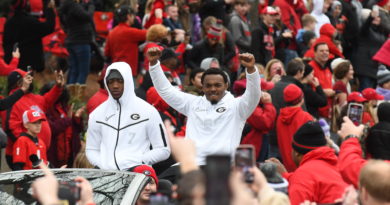Nostalgia bait: a film industry flaw
With the film market becoming more saturated, it can be hard for newer intellectual properties (IPs) to stand out amongst giants. However, audiences are growing tired of re-featuring characters from previous iterations of franchises. Fans enjoy seeing returning characters, but when nothing is added to the character or plot, their addition acts as a glorified cameo. When former characters are reused solely for the purpose of getting butts in seats, it further grows the problem of nostalgia bait.
A notorious example of nostalgia bait is “The Flash (2023)” During the film, several actors from past movies make appearances, with and without their consent. CGI replicas of deceased actors George Reeves and Christopher Reeve, who previously played Superman, appear in the film. These characters engage in no dialogue and add nothing to the plot. The appearances from the deceased actors pose a moral dilemma: is it ethical for an actor’s likeness to be used in movies after their passing? Even though the families of the actors gave permission, with the actors themselves not being able to do so, their usage can feel soulless.
With the inclusion of the rushed and unfinished CGI, the lifeless puppets should have never been in the film. These cameos, while intending to be a tribute, come off as nothing more than attention grabbers.
Another example includes “Jurassic World Dominion.” The film features returning roles Alan Grant (Sam Neill), Ellie Sattler (Laura Dern) and Ian Malcom (Jeff Goldblum) from the previous “Jurassic Park” trilogy. These characters, despite being featured heavily throughout the film, merely act as an eye-catcher for fans, adding little to the plot. Goldblum also made a brief appearance in the previous film “Jurassic World: Fallen Kingdom,” however, the misleading trailer falsely portrayed him as an important character.
Still, nostalgia can be used positively. “Spider-Man: No Way Home” features returning characters from the previous movies, such as Green Goblin (Willem Dafoe) from 2002’s “Spider-Man.” During the film, actors Tobey Maguire and Andrew Garfield used their roles as experienced Spider-men to guide Tom Holland’s Peter Parker into a more complex character by showing him what it means to be Spider-Man. Marvel studios used the characters not only to connect spider-men from different universes, but also to show that they’re not alone in their struggles. By connecting past and present characters in this movie, it allows fans of the different iterations of Spider-Man to not only enjoy the film, but also see their characters be allowed to shine once again.
It can be difficult for studios to find an acceptable reason for past characters to return. Hollywood however, continues to pump out prequels, sequels and reboots of pre-established IPs. When a new trailer comes out it’s hard for audiences to draw the line and determine if a character they love is being properly utilized or simply a puppet of a greedy executive.
Box office numbers are another reflection of an IP’s performance. Profits are calculated by multiplying the budget by 2.5 to account for marketing expenses. One could point to the success of “Spider-Man: No Way Home” as an example of Hollywood profiting off of a popular character, with the film earning $1.9 billion against a budget of $200 million. However, “The Flash” only earned $271.3 million against a budget of $220 million, losing Warner Bros. and estimated $200 million. Though the difference between films could be attributed to controversial members of the cast, other films that use legacy characters repeat these box office bombs. “Indiana Jones and the Dial of Destiny” cost $295 million to make. The film ended up only grossing $384 million and lost Disney $134.2 million. The point here is that some reused IPs will have successful runs in theaters. Others, whether its criminal actors or simply an uninterest in the property, will not. It’s clear the market on nostalgic characters ebbs and flows.
The bottom line is, audiences love and hate the usage of nostalgic characters. An effective use of characters is encouraged, but when they become an audience lure from a greedy executive, the tactic enters a gray area. The returning IPs must be given a purposeful reason to come back, or else their usage feels cheap. When a character’s story is wrapped up then a pointless continuation is made, that also reflects badly on the franchise. Studios shouldn’t take characters people love and change their personality or motives with disregard for the original material, such as what happened to Luke Skywalker (Mark Hamill) in “Star Wars: The Last Jedi.” Directors, producers and executives need to respect their audiences before they begin to feature legacy characters in newer projects.




